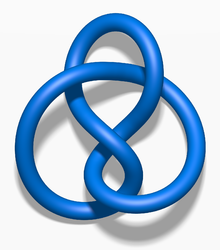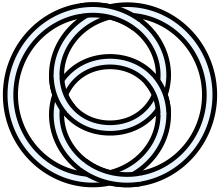Achterknoten (Mathematik)
aus Wikipedia, der freien Enzyklopädie

Der Achterknoten (oder Achtknoten) spielt in der Mathematik, speziell in der Knotentheorie, eine Rolle. Er ist das mathematische Gegenstück des Achtknotens, der unter anderem beim Segeln gebraucht wird.
Parameterdarstellung
[Bearbeiten | Quelltext bearbeiten]Eine einfache Parameterdarstellung des Achterknotens ist:[1]
Der Achterknoten ist der Abschluss des Zopfes .
Invarianten
[Bearbeiten | Quelltext bearbeiten]Das Alexander-Polynom des Achterknotens ist
sein Jones-Polynom
Das Kauffman-Polynom ist , das HOMFLY-Polynom , das Klammerpolynom , das Conway-Polynom und das BLM-Polynom .
Die Kreuzungszahl des Achterknotens ist 4, sein Geschlecht ist 1 und seine Seifert-Matrix .
Die Knotengruppe des Achterknotens hat die Präsentierung
- .
Ihre Charaktervarietät ist die elliptische Kurve[2]
das A-Polynom ist
Eigenschaften
[Bearbeiten | Quelltext bearbeiten]Der Achterknoten ist achiral (auch amphichiral genannt), das heißt, er ist in sein Spiegelbild deformierbar. Er ist kein Torusknoten.
Der Achterknoten ist ein hyperbolischer Knoten, sein hyperbolisches Volumen beträgt
Hierbei ist der Bloch-Wigner-Dilogarithmus und .
Die hyperbolische Struktur ist gegeben durch die treue und diskrete Darstellung
- .
Die hyperbolische Struktur auf dem Komplement des Achterknotens wurde 1975 von Riley entdeckt.[3] Dieses Beispiel motivierte Thurston zur Suche nach hyperbolischen Strukturen auf weiteren Knotenkomplementen, was letztlich in die Geometrisierungsvermutung mündete.
Der Achterknoten ist der einzige arithmetische hyperbolische Knoten.[4]
Cao und Meyerhoff haben 2001 bewiesen, dass der Achterknoten der hyperbolische Knoten kleinsten Volumens ist.[5]
 |
 |
 |
Siehe auch
[Bearbeiten | Quelltext bearbeiten]Weblinks
[Bearbeiten | Quelltext bearbeiten]Einzelnachweise
[Bearbeiten | Quelltext bearbeiten]- ↑ Eric W. Weisstein: Figure Eight Knot. In: MathWorld (englisch).
- ↑ Mehmet Haluk Șengün: An introduction to A-polynomials and their Mahler measures.
- ↑ Robert Riley: A quadratic parabolic group. Math. Proc. Cambridge Philos. Soc. 77 (1975), 281–288.
- ↑ Alan Reid: Arithmeticity of Knot Complements. J. London Math. Soc. (2) 43 (1991), no. 1, 171–184.
- ↑ Chun Cao, Robert Meyerhoff: The orientable cusped hyperbolic 3-manifolds of minimum volume. Invent. Math. 146 (2001), no. 3, 451–478.
Text is available under the CC BY-SA 4.0 license; additional terms may apply.
Images, videos and audio are available under their respective licenses.










![{\displaystyle \Gamma =\langle a,b\mid \left[a^{-1},b\right]a=b\left[a^{-1},b\right]\rangle }](https://wikimedia.org/api/rest_v1/media/math/render/svg/9922cf6981f3844d900f096c6f2bc5a16cb7803e)






![{\displaystyle \rho \colon \Gamma \to PSL(2,\mathbb {Z} \left[\omega \right])\subset PSL(2,\mathbb {C} )=Isom^{+}(H^{3})}](https://wikimedia.org/api/rest_v1/media/math/render/svg/a436b466dbcefa53e42185c699cfa923c2fa5754)


